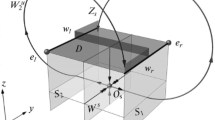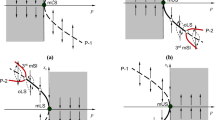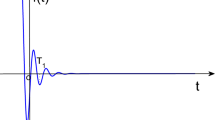Abstract
Sliding dynamics is a peculiar phenomenon to discontinuous dynamical systems, while homoclinic orbits play a role in studying the global dynamics of dynamical systems. This paper provides a method to ensure the existence of sliding homoclinic orbits of three-dimensional piecewise affine systems. In addition, sliding cycles are obtained by bifurcations of the systems with sliding homoclinic orbits to saddles. Two examples with simulations of sliding homoclinic orbits and sliding cycles are provided to illustrate the effectiveness of the results.













Similar content being viewed by others
References
Battelli, F., Fečkan, M.: Bifurcation and chaos near sliding homoclinics. J. Differ. Equ. 248, 2227–2262 (2010)
Battelli, F., Fečkan, M.: An example of chaotic behaviour in presence of a sliding homoclnic orbits. Annali. di. Matematica. 189, 615–642 (2010)
Bonet-Reves, C., Seara, T.M.: Regularization of sliding global bifurcations derived from the local fold singularity of filippov systems. Discrete Cont. Dyn. 36, 3545–3601 (2016)
Belykh, V.N., Barabash, N.V., Belykh, I.V.: Sliding homoclinic bifurcations in a Lorenz-type system: analytic proofs. Chaos. 31: 043117 (1–17) (2021)
Carmona, V., Fernández-Sánchez, F., Teruel, García-Medina, E., Antonio, E.: Existence of homoclinic connections in continuous piecewise linear systems, Chaos. 20, 013124(1–8) (2010)
Colombo, A., Jeffrey, M.R.: Nondeterministic chaos, and the two-fold singularity in piecewise smooth flows. Siam J. Appl. Dyn. Syst. 10, 423–451 (2011)
Carvalho, T., Novaes, D.D., Goncalves, L.F.: Sliding Shilnikov connection in Filippov-type predator-prey model. Nonlinear Dyn. 100, 2973–2987 (2020)
Di Bernardo, M., Budd, C.J., Champneys, A.R., Kowalczyk, P.: Piecewise-Smooth Dynamical Systems: Theory and Applications. Springer, Berlin (2008)
Di Bernardo, M., Montanaro, U., Ortega, R., Santini, S.: Extended hybrid model reference adaptive control of piecewise affine systems. Nonlinear Anal. Hybrid. 21, 11–21 (2016)
Filippov, A.F.: Differential equations with discontinuous right-hand sides. Kluwer Acdemic Publishers, Dordrecht (1988)
Glendinning, P., Kowalczyk, P., Nordmark, A.B.: Attractors near grazing-sliding bifurcations. Nonlinearity. 25, 1867–1885 (2012)
Glendinning, P.A.: Shilnikov chaos, filippov sliding and boundary equilibrium bifurcations. Eur. J. Appl. Math. 29, 757–777 (2018)
Huan, S.M., Yang, X.-S.: Existence of chaotic invariant set in a class of 4-dimensional piecewise linear dynamical systems. Int. J. Bifurc. Chaos. 24, 1450158 (2014)
Jeffrey, M.R., Hogan, S.J.: The geometry of generic sliding bifurcations. Siam Rev. 53, 505–525 (2011)
Kuznetsov, Y.A., Rinaldi, S., Gragnani, A.: One parameteric bifurcations in planar Filippov systems. Int. J. Bifurc. Chaos. 13, 2157–2188 (2003)
Li, T.C., Chen, G.T., Chen, G.R.: On homoclinic and heteroclinic orbits of Chen’s system. Int. J. Bifurc. Chaos. 16, 3035–3041 (2006)
Li, J.B., Chen, F.J.: Exact homoclinic orbits and heteroclinic families for a third-order system in the Chazy class XI (N=3). Int. J. Bifurc. Chaos. 21, 3305–3322 (2011)
Li, W., Huang, L., Wang, J.: Global asymptotical stability and sliding bifurcation analysis of a general filippov-type predator-prey model with a refuge. Appl. Math. Comput. 405, 126263 (2021)
Novaes, D.D., Ponce, G., Varão, R.: Chaos induced by sliding phenomena in filippov systems. J. Dyn. Diff. Equ. 29, 1569–1583 (2017)
Novaes, D.D., Teixeira, M.A.: Shilnikov problem in Filippov dynamical systems. Chaos. 29, 063110 (2019)
Pi, D., Yu, J., Zhang, X.: On the sliding bifurcation of a class of planar Filippov systems. Int. J. Bifur. Chaos. 23, 1350040 (2013)
Pulecio-Montoya, A.M., López-Montenegro, L.E., Cerón-Caicedo, J.: Sliding dynamic in a 3-dimensional epidemiological system. Math. Comput. Simul. 185, 570–582 (2021)
Qiao, Z., Zhu, D., Lu, Q.: Bifurcation of a heterodimensional cycle with weak inclination flip. Discrete Cont. Dyn-B. 17, 1009–1025 (2012)
Simpson, D.J.W.: Grazing-sliding bifurcations creating infinitely many attractors. Int. J. Bifurcat. Chaos. 27, 1730042 (2017)
Wiggins, S.: Global Bifurcations and Chaos Analytical Methods. Springer-Verlag, New York (1988)
Wei, L., Zhang, X.: Limit cycle bifurcations near generalized homoclinic loop in piecewise smooth differential systems. Discrete Cont. Dyn. 36, 2803–2825 (2016)
Wu, T., Yang, X.-S.: A new class of 3-dimensional piecewise affine systems with homoclinic orbits. Discrete Cont. Dyn. 36, 5119–5129 (2016)
Wu, T., Yang, X.-S.: Construction of a class of four-dimensional piecewise affine systems with homoclinic orbits. Int. J. Bifurcat. Chaos. 26, 1650099 (2016)
Wu, T., Yang, X.-S.: Horseshoes in 4-dimensional piecewise affine systems with bifocal heteroclinic cycles. Chaos 28, 113120 (2018)
Wu, T., Yang, X.-S.: On the existence of homoclinic orbits in n-dimensional piecewise affine systems. Nonlinear Anal. Hybrid. 27, 366–389 (2018)
Acknowledgements
This work is supported by National Natural Science Foundation of China (11801329, 11301196) and Natural Science Foundation of Shandong province (ZR2018BA002).
Author information
Authors and Affiliations
Corresponding author
Ethics declarations
Conflict of interest
The authors declare that there is no conflict of interest with respect to the research. All authors contributed to the study conception and design. Analysis and writing were performed by Tiantian Wu and Songmei Huan. Simulations were performed by Xiaojuan Liu. All authors read and approved the final manuscript. The datasets generated during the current study are available in the paper.
Additional information
Publisher's Note
Springer Nature remains neutral with regard to jurisdictional claims in published maps and institutional affiliations.
Appendices
Appendix A: The proof of Lemma 1
The sliding system (12) can be written as
for \(\textbf{x}_s=(0\quad y\quad z)^\intercal \in \Sigma _{s}\), where \(\textbf{A}=(a_{ij})_{3\times 3}\), \(\mathbf {B(\mu )}=(b_{ij})_{3\times 3}\), \(\textbf{a}=(a_i)_{3\times 1}\) and \(\textbf{b}(\mu )=(b_i)_{3\times 1}\), \(i, j=1, 2, 3\).
Hence, system (12) is an affine system if and only if there exist constants \(k_1\), \(k_2\) and \(k_3\) such that
or
Since \(\textbf{x}_s=(0\quad y\quad z)^\intercal \in \Sigma _{s}\), then
and \(0<k_1<1\). If Eq. (1) holds, then
If Eqs. (2) and (3) hold, then
And then the sliding system (12) is
Lemma 1 is proved.
Appendix B: The proof of Lemma 2
The sliding system (13) can be written as
for \(\textbf{x}_s=(0\quad y\quad z)^\intercal \in \Sigma _{s}\), where \(\textbf{A}=(a_{ij})_{3\times 3}\), \(\mathbf {B(\mu )}=(b_{ij})_{3\times 3}\), \(\textbf{a}=(a_i)_{3\times 1}\) and \(\textbf{b}(\mu )=(b_i)_{3\times 1}\), \(i, j=1, 2, 3\).
Hence, system (13) is an affine system if and only if
And then the sliding system (13) is
Lemma 2 is proved.
Rights and permissions
Springer Nature or its licensor (e.g. a society or other partner) holds exclusive rights to this article under a publishing agreement with the author(s) or other rightsholder(s); author self-archiving of the accepted manuscript version of this article is solely governed by the terms of such publishing agreement and applicable law.
About this article
Cite this article
Wu, T., Huan, S. & Liu, X. Sliding homoclinic orbits and bifurcations of three-dimensional piecewise affine systems. Nonlinear Dyn 111, 9011–9024 (2023). https://doi.org/10.1007/s11071-023-08301-4
Received:
Accepted:
Published:
Issue Date:
DOI: https://doi.org/10.1007/s11071-023-08301-4




